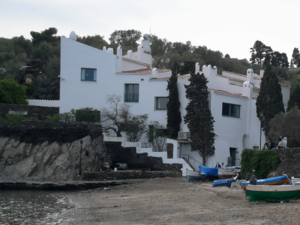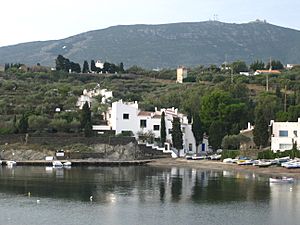Salvador Dalí House Museum facts for kids
| Casa-Museu Salvador Dalí | |
 |
|
| Established | 1997 |
|---|---|
| Location | Portlligat, Cadaqués, Spain |
| Type | House museum |
The Salvador Dalí House Museum is a special place in Portlligat, Cadaqués, Spain. It was once the home and workplace of the famous Spanish painter Salvador Dalí. He lived there from 1930 until 1982. After his wife, Gala Dalí, passed away, he moved to another castle. His house was turned into a museum and opened in 1997. It is now managed by the Gala-Salvador Dalí Foundation. This unique house is considered a "Site of Cultural Interest."
Contents
History of Dalí's Home
Salvador Dalí's unique house started as a small fisherman's hut in Portlligat. In 1929, Dalí bought the first hut. Soon after, he bought a second one. He slowly added more huts over the years, connecting them to create his home.
Building the House Over Time
The first changes to make the huts into a home were done by a bricklayer named Joaquim Ferrer. By 1935, a new floor was added to the first two huts. They were covered with a single roof, and each had a window looking out at the bay.
In 1942, Dalí and Gala bought another hut at the top end. This hut became their library. The furniture inside was specially designed by a local carpenter. Later, in 1954, they bought the last hut. In 1962, a private room for Gala was built on a new floor.
From Home to Museum
After Gala's death in 1982, Dalí never returned to Portlligat. He passed away in 1989. The house was then prepared to become a museum. This work began in 1994 and was led by architects Oriol Clos i Costa and José Ramos Illán. The new museum finally opened its doors in 1997.
Exploring the Dalí House Museum
The house is made up of many small fisherman's huts joined together. It feels like a maze inside! From the main entrance, called the Bear Hall, the house spreads out. You'll find many rooms connected by narrow hallways and slight changes in floor level.
All the rooms have windows of different shapes. These windows perfectly frame the Portlligat bay. This view was very important in Dalí's artwork. The house itself is a mix of different styles, showing Dalí's love for surrealism and unique art.
Inside the House: Three Main Areas
The house is divided into three main parts. These include the private living areas for the Dalí family, Dalí's art studio, and the outdoor spaces.
The Bear Hall
The first room you enter is the Bear Hall. It's guarded by a large stuffed bear! This bear was a gift to Dalí and Gala. It holds a lamp and also works as an umbrella stand and letter holder. Behind the bear, there's a stuffed owl. These animals show how much Dalí loved taxidermy, which is the art of preparing, stuffing, and mounting animal skins. Dalí once said, "Here, in this house, everything is stuffed."
Dalí's Art Studio
One of the most important rooms is the studio. This is where Dalí spent many hours creating his famous artworks. The room is quiet and well-lit. You can still see his easels, brushes, paints, and other tools he used.
The Model Room
Next to the studio is the Model Room. Here, you'll find more tools and special optical equipment. A small plaster bust of the Roman Emperor Nero is a key feature in this room. This bust inspired Dalí's painting Dematerialization of Nero's Nose (1947). He created this painting when he was very interested in nuclear fusion.
Gala's Oval Room
Just like Salvador Dalí, his wife Gala had her own private space. It's called the Oval Room. She used this room to read and to welcome important guests. This room was built in 1961. It's shaped like a sphere and has interesting acoustics, meaning sounds echo in a special way. To reach the Oval Room, you first walk through Gala's boudoir (a private dressing room) and the Photograph Room. This dressing room has cupboards full of photos and magazine clippings. They show Dalí and Gala with many different people, showing how active they were in public life.
Outdoor Spaces
The Courtyard
Outside, the courtyard is a highlight. You reach it through a small maze that hides a summer dining area. The courtyard is decorated with two huge cup-shaped planters. There's also a copy of Ilisos, a famous sculpture by the Ancient Greek artist Phidias. The original was made for the Parthenon in Athens.
The Swimming Pool
At the back of the courtyard is the swimming pool, built in 1967. This is perhaps the most eye-catching part of the house. It has lots of wild and surreal decorations. These include a sofa shaped like lips, fountains shaped like swans, and posters for Pirelli tires.
Other Unique Decorations
Many other items complete the house's decoration and show Dalí's personal style. You'll see countless eggs, strange heads, a dovecote (a home for doves) shaped like gallows, and a sculpture called Christ of the Debris. This sculpture was made from pieces left over after a flood.
See also
 In Spanish: Casa-Museo Salvador Dalí para niños
In Spanish: Casa-Museo Salvador Dalí para niños
- List of single-artist museums
Gallery





